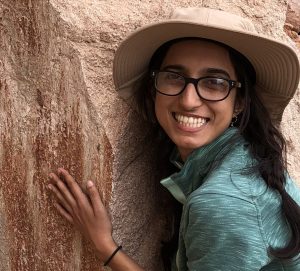Physical Volcanology of Fragmented Volcanic Rocks in the Miocene Jacaumba/Alverson Volcanics, Devil’s Canyon, California

BS Candidate
Advisor – Dr. Vic Camp
Friday, May 8th, 2020
at 10:30am – via zoom
watch Javaia’s defense here
Abstract
The surface geology at Devil’s Canyon, 9 km west of Ocotillo, California, contains fragmented Miocene volcanic and epiclastic deposits overlaying Eocene fluvial conglomerate and sandstone, which in turn sits above the Cretaceous La Posta Pluton. The Miocene volcanic and volcaniclastic rocks form one of several scattered outcrops in the NW corner of the Sonora Desert mapped previously as the Jacumba volcanics and/or Alverson Formation. A stratigraphic section across the eastern half of the Devil’s Canyon exposure reveals the majority of the Devil’s Canyon rock types, although the thin Eocene fluvial deposit mapped near this section is not recognized at its base. Instead, the lowest unit comprises brecciated rocks of polylithologic character dominated by quartz-rich granitic clasts but also containing clasts of Miocene lava. The unit is poorly stratified but in places shows normal grading to fine sand and contains few scattered and discontinuous lenses of cross-bedded sandstone characteristic of lateral transport. The angularity of the clasts is consistent with debris-flow deposition in an alluvial-fan or channel-fill environment, where contemporaneous or later reworking of the deposit generated sandy lenses of fluvial transport. The granitic clasts decrease in abundance up section. The central part of the section contains brecciated flows devoid of granitic clasts. These units contain a polymictic variety of volcanic clasts supported by a muddy matrix, consistent with sedimentary deposition in the form of lahar deposits that are best exposed in valleys cutting through the SE part of the Devil’s Canyon exposure. The uppermost fragmented unit is widespread and the most intriguing. It has all the characteristics of a block-and-ash flow derived from collapse of a growing lava dome, a type of deposit that has not been previously described in the Jacumba/Alverson volcanic succession. Fundamental features that support this conclusion are: (a) hot rocks with radial cooling joints typically found in volcanic domes, (b) flow banding delineated by aligned vesicular zones that develop along shear surfaces during dome growth, (c) elevated temperatures of the ashy matrix reflected in weak welding of the deposit, (d) a monolithologic character consistent with a provenance of dome collapse, and (e) reverse grading due to mechanical agitation during fluidized flow.

